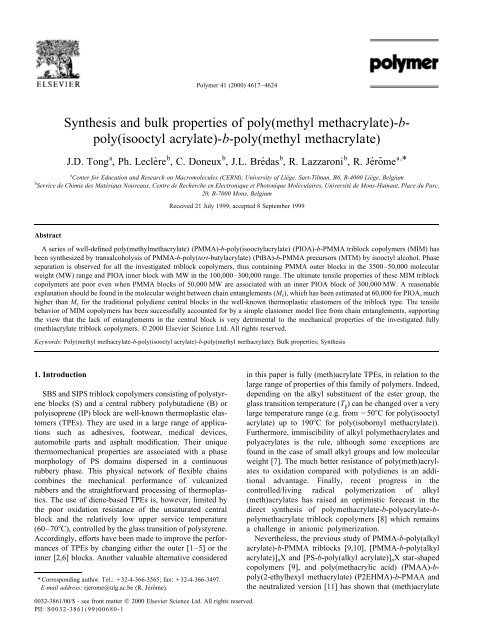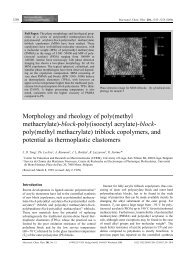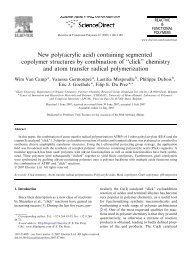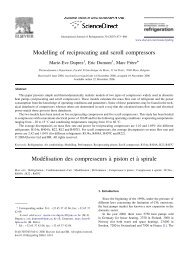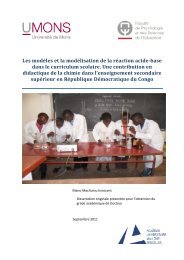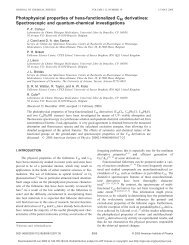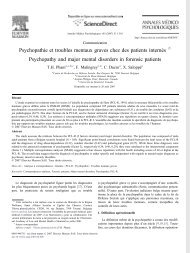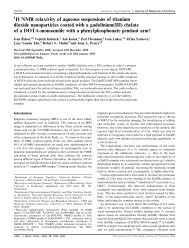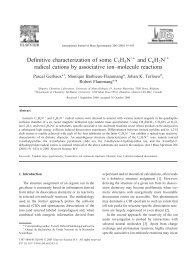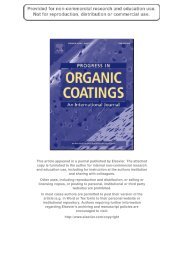Synthesis and bulk properties of poly(methyl methacrylate)-b- poly ...
Synthesis and bulk properties of poly(methyl methacrylate)-b- poly ...
Synthesis and bulk properties of poly(methyl methacrylate)-b- poly ...
Create successful ePaper yourself
Turn your PDF publications into a flip-book with our unique Google optimized e-Paper software.
Polymer 41 (2000) 4617–4624<br />
<strong>Synthesis</strong> <strong>and</strong> <strong>bulk</strong> <strong>properties</strong> <strong>of</strong> <strong>poly</strong>(<strong>methyl</strong> <strong>methacrylate</strong>)-b<strong>poly</strong>(isooctyl<br />
acrylate)-b-<strong>poly</strong>(<strong>methyl</strong> <strong>methacrylate</strong>)<br />
J.D. Tong a , Ph. Leclère b , C. Doneux b , J.L. Brédas b , R. Lazzaroni b ,R.Jérôme a, *<br />
a Center for Education <strong>and</strong> Research on Macromolecules (CERM), University <strong>of</strong> Liège, Sart-Tilman, B6, B-4000 Liège, Belgium<br />
b Service de Chimie des Matériaux Nouveaux, Centre de Recherche en Electronique et Photonique Moléculaires, Université de Mons-Hainaut, Place du Parc,<br />
20, B-7000 Mons, Belgium<br />
Received 21 July 1999; accepted 8 September 1999<br />
Abstract<br />
A series <strong>of</strong> well-defined <strong>poly</strong>(<strong>methyl</strong><strong>methacrylate</strong>) (PMMA)-b-<strong>poly</strong>(isooctylacrylate) (PIOA)-b-PMMA triblock co<strong>poly</strong>mers (MIM) has<br />
been synthesized by transalcoholysis <strong>of</strong> PMMA-b-<strong>poly</strong>(tert-butylacrylate) (PtBA)-b-PMMA precursors (MTM) by isooctyl alcohol. Phase<br />
separation is observed for all the investigated triblock co<strong>poly</strong>mers, thus containing PMMA outer blocks in the 3500–50,000 molecular<br />
weight (MW) range <strong>and</strong> PIOA inner block with MW in the 100,000–300,000 range. The ultimate tensile <strong>properties</strong> <strong>of</strong> these MIM triblock<br />
co<strong>poly</strong>mers are poor even when PMMA blocks <strong>of</strong> 50,000 MW are associated with an inner PIOA block <strong>of</strong> 300,000 MW. A reasonable<br />
explanation should be found in the molecular weight between chain entanglements (M e ), which has been estimated at 60,000 for PIOA, much<br />
higher than M e for the traditional <strong>poly</strong>diene central blocks in the well-known thermoplastic elastomers <strong>of</strong> the triblock type. The tensile<br />
behavior <strong>of</strong> MIM co<strong>poly</strong>mers has been successfully accounted for by a simple elastomer model free from chain entanglements, supporting<br />
the view that the lack <strong>of</strong> entanglements in the central block is very detrimental to the mechanical <strong>properties</strong> <strong>of</strong> the investigated fully<br />
(meth)acrylate triblock co<strong>poly</strong>mers. 2000 Elsevier Science Ltd. All rights reserved.<br />
Keywords: Poly(<strong>methyl</strong> <strong>methacrylate</strong>-b-<strong>poly</strong>(isooctyl acrylate)-b-<strong>poly</strong>(<strong>methyl</strong> <strong>methacrylate</strong>); Bulk <strong>properties</strong>; <strong>Synthesis</strong><br />
1. Introduction<br />
SBS <strong>and</strong> SIPS triblock co<strong>poly</strong>mers consisting <strong>of</strong> <strong>poly</strong>styrene<br />
blocks (S) <strong>and</strong> a central rubbery <strong>poly</strong>butadiene (B) or<br />
<strong>poly</strong>isoprene (IP) block are well-known thermoplastic elastomers<br />
(TPEs). They are used in a large range <strong>of</strong> applications<br />
such as adhesives, footwear, medical devices,<br />
automobile parts <strong>and</strong> asphalt modification. Their unique<br />
thermomechanical <strong>properties</strong> are associated with a phase<br />
morphology <strong>of</strong> PS domains dispersed in a continuous<br />
rubbery phase. This physical network <strong>of</strong> flexible chains<br />
combines the mechanical performance <strong>of</strong> vulcanized<br />
rubbers <strong>and</strong> the straightforward processing <strong>of</strong> thermoplastics.<br />
The use <strong>of</strong> diene-based TPEs is, however, limited by<br />
the poor oxidation resistance <strong>of</strong> the unsaturated central<br />
block <strong>and</strong> the relatively low upper service temperature<br />
(60–70C), controlled by the glass transition <strong>of</strong> <strong>poly</strong>styrene.<br />
Accordingly, efforts have been made to improve the performances<br />
<strong>of</strong> TPEs by changing either the outer [1–5] or the<br />
inner [2,6] blocks. Another valuable alternative considered<br />
* Corresponding author. Tel.: 32-4-366-3565; fax: 32-4-366-3497.<br />
E-mail address: rjerome@ulg.ac.be (R. Jérôme).<br />
in this paper is fully (meth)acrylate TPEs, in relation to the<br />
large range <strong>of</strong> <strong>properties</strong> <strong>of</strong> this family <strong>of</strong> <strong>poly</strong>mers. Indeed,<br />
depending on the alkyl substituent <strong>of</strong> the ester group, the<br />
glass transition temperature (T g ) can be changed over a very<br />
large temperature range (e.g. from 50C for <strong>poly</strong>(isooctyl<br />
acrylate) up to 190C for <strong>poly</strong>(isobornyl <strong>methacrylate</strong>)).<br />
Furthermore, immiscibility <strong>of</strong> alkyl <strong>poly</strong><strong>methacrylate</strong>s <strong>and</strong><br />
<strong>poly</strong>acrylates is the rule, although some exceptions are<br />
found in the case <strong>of</strong> small alkyl groups <strong>and</strong> low molecular<br />
weight [7]. The much better resistance <strong>of</strong> <strong>poly</strong>(meth)acrylates<br />
to oxidation compared with <strong>poly</strong>dienes is an additional<br />
advantage. Finally, recent progress in the<br />
controlled/living radical <strong>poly</strong>merization <strong>of</strong> alkyl<br />
(meth)acrylates has raised an optimistic forecast in the<br />
direct synthesis <strong>of</strong> <strong>poly</strong><strong>methacrylate</strong>-b-<strong>poly</strong>acrylate-b<strong>poly</strong><strong>methacrylate</strong><br />
triblock co<strong>poly</strong>mers [8] which remains<br />
a challenge in anionic <strong>poly</strong>merization.<br />
Nevertheless, the previous study <strong>of</strong> PMMA-b-<strong>poly</strong>(alkyl<br />
acrylate)-b-PMMA triblocks [9,10], [PMMA-b-<strong>poly</strong>(alkyl<br />
acrylate)] n X <strong>and</strong> [PS-b-<strong>poly</strong>(alkyl acrylate)] n X star-shaped<br />
co<strong>poly</strong>mers [9], <strong>and</strong> <strong>poly</strong>(methacrylic acid) (PMAA)-b<strong>poly</strong>(2-ethylhexyl<br />
<strong>methacrylate</strong>) (P2EHMA)-b-PMAA <strong>and</strong><br />
the neutralized version [11] has shown that (meth)acrylate<br />
0032-3861/00/$ - see front matter 2000 Elsevier Science Ltd. All rights reserved.<br />
PII: S0032-3861(99)00680-1
4618<br />
J.D. Tong et al. / Polymer 41 (2000) 4617–4624<br />
1,1-diphenylethylene (DPE, Aldrich) was vacuum distilled<br />
over s-BuLi <strong>and</strong> diluted by toluene (ca. 0.3 N). Isooctyl<br />
alcohol (3 M) was used as received. LiCl (99.99%, Aldrich)<br />
was dried under vacuum at 130C.<br />
based triblock co<strong>poly</strong>mers have rather poor ultimate<br />
mechanical <strong>properties</strong> (s B 10 MPa <strong>and</strong> 1 500%)<br />
compared to traditional diene-based TPEs (s B 30 MPa<br />
<strong>and</strong> 1 800–1000%). Several reasons have been proposed<br />
to account for the poor mechanical <strong>properties</strong> <strong>of</strong> these fully<br />
(meth)acrylate triblocks, such as (partial) miscibility <strong>of</strong> the<br />
constitutive blocks [12], sample preparation by compression<br />
molding at a temperature at which melt viscosity remains<br />
very high [9,13], too short outer blocks [11] <strong>and</strong> poor<br />
control <strong>of</strong> the block co<strong>poly</strong>mer structure [10]. Actually,<br />
except for the synthesis, little is known about the <strong>properties</strong><br />
<strong>of</strong> this kind <strong>of</strong> materials. The main pending question is<br />
certainly to know whether the poor mechanical performances<br />
are intrinsic to this type <strong>of</strong> triblock co<strong>poly</strong>mers or<br />
result from lack <strong>of</strong> control in the synthesis <strong>and</strong>/or processing<br />
<strong>of</strong> the samples. In order to answer this question, a series <strong>of</strong><br />
PMMA-b-<strong>poly</strong>-(isooctyl acrylate)-b-PMMA, or MIM, triblock<br />
co<strong>poly</strong>mers has been synthesized by sequential living<br />
anionic <strong>poly</strong>merization <strong>of</strong> MMA, tert-butyl acrylate (tBA)<br />
<strong>and</strong> MMA, followed by the selective transalcoholysis <strong>of</strong> the<br />
central PtBA block by isooctyl alcohol. All these triblocks<br />
have been characterized by size exclusion chromatography<br />
(SEC), differential scanning calorimetry (DSC), dynamic<br />
mechanical analysis (DMTA) <strong>and</strong> atomic force microscopy<br />
(AFM). Although the molecular structure is well-controlled<br />
(e.g. M w =M n 1:1) <strong>and</strong> the phase separation is clearly<br />
observed, the ultimate tensile <strong>properties</strong> <strong>of</strong> these physically<br />
vulcanized rubbers remain much lower than the traditional<br />
styrene–diene counterparts. So, the origin for this disappointing<br />
observation should be found in the chemical<br />
composition <strong>of</strong> the triblocks, as will be discussed further.<br />
2. Experimental section<br />
2.1. Materials<br />
Scheme 1.<br />
THF <strong>and</strong> toluene were purified by refluxing over the deep<br />
purple sodium-benzophenone complex. MMA <strong>and</strong> tBA<br />
(Aldrich) were refluxed over CaH 2 , vacuum distilled <strong>and</strong><br />
stored under nitrogen at 20C. Before <strong>poly</strong>merization,<br />
they were added with a 10 wt% AlEt 3 solution in hexane<br />
until a persistent yellowish green color was observed, <strong>and</strong><br />
distilled under reduced pressure just prior to use (tBA was<br />
diluted by the same volume <strong>of</strong> toluene before distillation).<br />
sec-Butyllithium (s-BuLi) (Aldrich, 1.3 M solution in<br />
cyclohexane) was diluted by cyclohexane (ca. 0.25 N).<br />
2.2. <strong>Synthesis</strong> <strong>of</strong> <strong>poly</strong>MMA-b-<strong>poly</strong>tBA-b-<strong>poly</strong>MMA (MTM)<br />
precursors<br />
A known amount <strong>of</strong> LiCl was added to a glass reactor that<br />
was flamed under vacuum <strong>and</strong> purged with nitrogen. THF<br />
<strong>and</strong> DPE were transferred into the glass reactor by using<br />
rubbery septa <strong>and</strong> stainless steel capillaries or syringes.<br />
Three-fold molar excess <strong>of</strong> DPE <strong>and</strong> five-fold molar excess<br />
<strong>of</strong> LiCl were used with respect to s-BuLi. The initiator<br />
solution was then added dropwise until a red color persisted,<br />
followed by the desired amount <strong>of</strong> initiator. The solution<br />
was cooled down to 78C <strong>and</strong> added with the required<br />
amount <strong>of</strong> MMA. The <strong>poly</strong>merization was conducted at<br />
78C for 1 h. Upon MMA addition, the deep red color<br />
<strong>of</strong> the initiator immediately disappeared, indicating an<br />
instantaneous initiation. The sequential addition <strong>and</strong> <strong>poly</strong>merization<br />
<strong>of</strong> tBA <strong>and</strong> MMA were carried out under the<br />
same conditions. The co<strong>poly</strong>merization product was<br />
quenched by degassed methanol <strong>and</strong> the final solution was<br />
concentrated before being precipitated into an excess <strong>of</strong> 90/<br />
10 (v/v) methanol/water mixture under stirring. The crude<br />
co<strong>poly</strong>mer was dried under vacuum at 60–80C overnight.<br />
2.3. Derivatization <strong>of</strong> <strong>poly</strong>MMA-b-<strong>poly</strong>IOA-b-<strong>poly</strong>MMA<br />
(MIM) co<strong>poly</strong>mers<br />
On the basis <strong>of</strong> preliminary experiments, the best conditions<br />
for the transalcoholysis <strong>of</strong> the tBA units <strong>of</strong> MTM<br />
co<strong>poly</strong>mers consisted in dissolving the co<strong>poly</strong>mers in an<br />
excess <strong>of</strong> isooctyl alcohol in the presence <strong>of</strong> p-toluenesulfonic<br />
acid (PTSA; 10 mol% with respect to tBA units). After<br />
reflux at 150C for 48 h, the co<strong>poly</strong>mer was recovered by<br />
precipitation in methanol <strong>and</strong> dried under vacuum at 80C<br />
overnight. Scheme 1 (synthesis <strong>of</strong> MIM triblock co<strong>poly</strong>mers)<br />
summarizes the main steps for the synthesis <strong>of</strong> the<br />
MIM co<strong>poly</strong>mers.<br />
PIOA <strong>of</strong> the same microstructure as the central PIOA<br />
block in the MIM triblocks was also prepared by transalcoholysis<br />
<strong>of</strong> PtBA homo<strong>poly</strong>mer by isooctyl alcohol as<br />
detailed above. PtBA was synthesized by anionic <strong>poly</strong>merization<br />
<strong>of</strong> tBA in THF in the presence <strong>of</strong> LiCl([LiCl]/<br />
[Li] ˆ 5) at 78C for 30 min.<br />
2.4. Sample preparation.<br />
Films were prepared by casting a co<strong>poly</strong>mer solution<br />
(8 wt%; 160 ml) in a 100 mm diameter <strong>poly</strong>ethylene dish.<br />
The solvent was evaporated over 3–4 days at room temperature.<br />
Films were dried to constant weight in a vacuum oven<br />
at 80C for ca. 1 day. They were colorless, transparent <strong>and</strong><br />
elastomeric, with a smooth surface.
J.D. Tong et al. / Polymer 41 (2000) 4617–4624 4619<br />
2.5. Analysis<br />
Molecular weight <strong>and</strong> molecular weight distribution were<br />
measured by size exclusion chromatography (SEC) in THF<br />
with a Hewlett-Packard 1090 apparatus equipped with<br />
linear styragel columns. PMMA st<strong>and</strong>ards were used for<br />
calibration.<br />
1 H NMR spectra were recorded with a Bruker AM-250<br />
spectrometer by using CDCl 3 as solvent at 25C. Composition<br />
<strong>of</strong> the diblock <strong>and</strong> the final MTM triblocks was calculated<br />
from the relative intensity <strong>of</strong> the signals for the O–CH 3<br />
protons in PMMA (3.6 ppm), <strong>and</strong> the –C(CH 3 ) 3 protons in<br />
PtBA (1.4 ppm). M n <strong>of</strong> the PtBA block (in the intermediate<br />
diblock) <strong>and</strong> the final MTM triblock was calculated from the<br />
co<strong>poly</strong>mer composition <strong>and</strong> molecular weight <strong>of</strong> the first<br />
PMMA block.<br />
DSC analysis was carried out with a DuPont 910 calorimeter<br />
at heating rates <strong>of</strong> 10–20C/min.<br />
Dynamic mechanical <strong>properties</strong> <strong>of</strong> the MIM co<strong>poly</strong>mers<br />
were measured with a Polymer Laboratory DMTA. 7 mm<br />
diameter samples were cut from 1–2 mm thick solution cast<br />
films. They were tested in the shear mode (1 Hz frequency;<br />
1% strain) at a scanning rate <strong>of</strong> 2C/min.<br />
Viscoelastic <strong>properties</strong> <strong>of</strong> PIOA were measured by using<br />
the RSI ARES rheometer equipped with the cone-plate<br />
geometry (25 mm diameter, 4 cone angle <strong>and</strong> 56 mm gap<br />
between the cone tip <strong>and</strong> the plate).<br />
AFM images were recorded with a Nanoscope IIIa microscope<br />
from Digital Instruments Inc. Details were reported<br />
elsewhere [13].<br />
Tensile <strong>properties</strong> were measured with an Adamel<br />
Lhomargy tensile tester. Microdumbells were cut from solution<br />
cast films <strong>and</strong> extended at 100 mm/min at room<br />
temperature. Strain was measured from the crosshead<br />
displacement. Sample thickness <strong>and</strong> width were 1.5 <strong>and</strong><br />
4 mm, respectively. At least three independent measurements<br />
were recorded for each sample.<br />
3. Results <strong>and</strong> discussion<br />
3.1. <strong>Synthesis</strong><br />
The prerequisite for drawing fundamental structure-property<br />
relationships for triblock type TPEs is the capability to<br />
synthesize these co<strong>poly</strong>mers with well-defined molecular<br />
architecture, chain microstructure, molecular weight,<br />
composition <strong>and</strong> narrow molecular weight distribution, in<br />
a large range <strong>of</strong> chain length. Living anionic <strong>poly</strong>merization<br />
is certainly a valuable way to achieve this target in case <strong>of</strong><br />
fully acrylic triblocks. Syndiotactic PMMA has been<br />
selected as the hard block, because <strong>of</strong> a T g close to 130C<br />
when MMA is anionically <strong>poly</strong>merized in THF at low<br />
temperature. In contrast to the anionic <strong>poly</strong>merization <strong>of</strong><br />
MMA <strong>and</strong> <strong>bulk</strong>y acrylates, such as tBA [14], which is living<br />
in THF at 78C, that <strong>of</strong> long-chain acrylates (e.g. n-butyl<br />
Fig. 1. Typical SEC traces for the three-stage synthesis <strong>of</strong> MTM co<strong>poly</strong>mers.<br />
(a) first PMMA block; (b) PMMA-b-PtBA; (c) MTM (sample 3,<br />
Table 1); (d) MIM.<br />
acrylate, isooctylacrylate) is usually out <strong>of</strong> control as result<br />
<strong>of</strong> nucleophilic side reactions. Therefore, the central PtBA<br />
block has been originally synthesized because <strong>of</strong> the ability<br />
<strong>of</strong> the tert-butyl ester group to undergo selective acid-catalyzed<br />
transalcoholysis by long-chain alcohols, with formation<br />
<strong>of</strong> low T g <strong>poly</strong>acrylate. Thus, a three-stage synthesis <strong>of</strong><br />
MTM triblocks has been initiated by s-BuLi in THF at<br />
78C. Fig. 1 illustrates the typical SEC traces <strong>of</strong> the<br />
PMMA first block, the intermediate PMMA-b-PtBA<br />
diblock <strong>and</strong> the final MTM triblock, respectively (sample<br />
3 in Table 1). Molecular weight distribution is <strong>and</strong> remains<br />
monomodal, symmetrical <strong>and</strong> narrow …M w =M n 1:1†:<br />
Furthermore, molecular weight increases with sequential<br />
block co<strong>poly</strong>merization, in good agreement with the value<br />
calculated from the monomer/initiator molar ratio. The<br />
sequential <strong>poly</strong>merization is thus perfectly controlled<br />
consistently with the livingness <strong>of</strong> each step <strong>and</strong> the reactivity<br />
matching <strong>of</strong> the two co-monomers. Table 1 lists the<br />
series <strong>of</strong> MTM triblock co<strong>poly</strong>mers that have been prepared<br />
in a large range <strong>of</strong> molecular weight (PMMA MW from<br />
3500 to 50,000; PtBA MW from 50,000 to 210,000) <strong>and</strong><br />
composition (PMMA content: 9–50 wt%). Monomer<br />
conversion is usually close to completion <strong>and</strong> <strong>poly</strong>dispersity<br />
narrow …M w =M n 1:2†: The MTM precursors have been<br />
converted into triblocks containing a central PIOA block<br />
<strong>of</strong> low T g . The acid catalyzed transalcoholysis <strong>of</strong> PtBA by<br />
alkyl alcohol in the presence <strong>of</strong> PMMA is selective [9,15]<br />
<strong>and</strong> highly quantitative (95–98%). 1 H NMR analysis <strong>of</strong> the<br />
original MTM <strong>and</strong> the final MIM co<strong>poly</strong>mers shows that no<br />
tBA group can be detected in MIM although some <strong>of</strong> them<br />
have been hydrolyzed rather than transalcoholyzed. Indeed,<br />
the signal at 1.4 ppm for the –C(CH 3 ) 3 protons <strong>of</strong> PtBA has<br />
completely disappeared upon transalcoholysis. In parallel,<br />
the signal at 4.0 ppm for the –O–CH 2 – protons <strong>of</strong> PIOA is<br />
observed in the case <strong>of</strong> MIM triblocks. The transalcoholysis<br />
yield is calculated from the relative intensity <strong>of</strong> the signals<br />
for the –O–CH 2 – protons <strong>of</strong> PIOA <strong>and</strong> the –O–CH 3<br />
protons <strong>of</strong> PMMA at 3.6 ppm, compared to the original<br />
molar composition <strong>of</strong> the MTM precursors. The SEC trace
4620<br />
J.D. Tong et al. / Polymer 41 (2000) 4617–4624<br />
Fig. 2. DSC traces for samples 1–4 <strong>and</strong> 6 (Table 2). Heating rate: 20C/min.<br />
Samples have been annealed at 140C for 5 h. Curves have been vertically<br />
shifted for the sake <strong>of</strong> clarity.<br />
<strong>of</strong> sample 3 after transalcoholysis, thus <strong>of</strong> the MIM triblock,<br />
is shown in Fig. 1. Table 1 shows that the transalcoholysis <strong>of</strong><br />
MTM into MIM triblocks does not change the MW distribution<br />
significantly. It may thus be concluded that fully<br />
acrylic analogues <strong>of</strong> the traditional TPEs <strong>of</strong> the SBS type<br />
can be tailored by sequential anionic <strong>poly</strong>merization <strong>of</strong><br />
MMA <strong>and</strong> tBA, followed by the selective transalcoholysis<br />
<strong>of</strong> the PtBA central block into a low T g PIOA block.<br />
3.2. DSC <strong>and</strong> DMTA studies<br />
Measurement <strong>of</strong> glass transition temperature is a common<br />
way to detect phase separation in multicomponent organic<br />
materials. As many glass transitions as immiscible components<br />
in a block co<strong>poly</strong>mer are predicted at temperatures<br />
that however depend on the extent <strong>of</strong> phase separation.<br />
Fig. 2 shows typical DSC traces for a series <strong>of</strong> MIM triblock<br />
co<strong>poly</strong>mers <strong>of</strong> increasing PMMA content (6.5–22%) <strong>and</strong><br />
MW (3500–20,000). In each case, a glass transition at ca.<br />
45C is clearly detected <strong>and</strong> assigned to PIOA. The independence<br />
<strong>of</strong> this T g <strong>of</strong> the PMMA content <strong>and</strong> MW is indicative<br />
<strong>of</strong> extensive phase separation. However, observation<br />
<strong>of</strong> T g for PMMA microphases is a problem except for<br />
sample 6, more likely due to low PMMA contents. Since<br />
DSC analysis is not sensitive enough to confirm unambiguously<br />
the two-phase morphology <strong>of</strong> the MIM triblock<br />
co<strong>poly</strong>mers, the temperature dependence <strong>of</strong> the dynamic<br />
shear modulus (G 0 ) has been measured for three MIM<br />
triblocks (samples 1–3). Fig. 3 shows a sharp drop <strong>of</strong> G 0<br />
at ca. –50C, which is characteristic <strong>of</strong> the PIOA glass<br />
transition. A rubbery plateau observed between ca. 0 <strong>and</strong><br />
100C for all the samples can only be explained by a threedimensional<br />
network <strong>of</strong> rubbery chains, as is observed for<br />
styrene–diene triblocks. In their study <strong>of</strong> binary blends <strong>of</strong><br />
SIPS triblocks with either SIP diblocks or PIP homo<strong>poly</strong>mers,<br />
Berglund <strong>and</strong> Mckay have shown that G 0 <strong>of</strong> the<br />
triblocks decreases in the plateau region as rapidly as the<br />
content <strong>of</strong> SIP or PIP is increased [16]. The very flat plateau<br />
in the temperature dependence <strong>of</strong> G 0 observed for the MIM<br />
samples (Fig. 3) indicates that the physical network <strong>of</strong> PIOA<br />
chains is essentially free from undesirable diblocks<br />
(PMMA–PIOA) or homo<strong>poly</strong>mers, which might have a<br />
detrimental effect on the ultimate mechanical <strong>properties</strong> <strong>of</strong><br />
the triblocks. At ca. 100C, G 0 for the MIM with the shortest<br />
PMMA block (sample 1) drops rapidly, which corresponds<br />
to the terminal zone, as is commonly observed for the traditional<br />
SBS <strong>and</strong> SIPS thermoplastic elastomers. The increase<br />
<strong>of</strong> the PMMA MW from 3.5K to 7K dramatically changes<br />
this situation. The onset <strong>of</strong> the terminal zone is observed at<br />
ca. 120C, thus ca. 30C higher than for sample 1. This<br />
temperature is also 30–40C higher than the value reported<br />
for the commercially available Kraton 1107 (SIPS, 10 K–<br />
120 K–10 K), which is thus a substantial improvement <strong>of</strong><br />
the upper service temperature. Nevertheless, sample 2 is not<br />
in the flow regime above 120C, since an additional plateau<br />
extending up to at least 200C is rapidly observed. This new<br />
characteristic feature, which is more pronounced for sample<br />
3 <strong>of</strong> higher PMMA MW, indicates that the ordered phase<br />
structure is maintained at high temperatures.<br />
3.3. Morphology<br />
Fig. 3. Shear modulus (G 0 ) vs. temperature at 1 Hz for samples 1–3 (Table<br />
2). Heating rate: 2C/min. For the sake <strong>of</strong> clarity, curves have been shifted<br />
upwards with respect to sample 1 (sample 2 by 0.5 unit; sample 3 by 1.0<br />
unit).<br />
Although DSC <strong>and</strong> DMTA strongly suggest that the<br />
PMMA <strong>and</strong> PIOA blocks are microphase separated, the<br />
most convincing evidence for a two-phase morphology is<br />
the direct observation on the nanometer scale. Although the<br />
phase morphology <strong>of</strong> fully (meth)acrylate block co<strong>poly</strong>mers<br />
cannot be detected by transmission electron microscopy<br />
because <strong>of</strong> lack <strong>of</strong> electronic contrast, atomic force microscopy<br />
(AFM) used in the tapping mode has proved highly<br />
efficient [13]. A previous paper has indeed reported that the<br />
well-known spherical, cylindrical <strong>and</strong> lamellar microphase<br />
structures were observed for MIM triblocks covering a large<br />
range <strong>of</strong> composition [13]. As an example, Fig. 4 shows two<br />
typical AFM images for samples 2 <strong>and</strong> 6 (Table 2), which
J.D. Tong et al. / Polymer 41 (2000) 4617–4624 4621<br />
Fig. 4. AFM images for (a) sample 2 in Table 2; (b) sample 6 in Table 2. The white area is characteristic <strong>of</strong> PMMA microphases.<br />
exhibit spheres <strong>and</strong> cylinders <strong>of</strong> PMMA (white microdomains),<br />
respectively. It is worth noting that MIM with<br />
very short PMMA blocks (sample 1 [13] <strong>and</strong> sample 2<br />
(Fig. 4a)) are phase separated, in contrast to the SBS <strong>and</strong><br />
SIPS analogues, which are monophase materials [17].<br />
3.4. Mechanical <strong>properties</strong><br />
Although the MIM triblocks <strong>of</strong> this series have welldefined<br />
molecular structure, exhibit distinct phase-separated<br />
morphology <strong>and</strong> show no evidence <strong>of</strong> contamination by<br />
diblock or homo<strong>poly</strong>mer, their ultimate tensile <strong>properties</strong><br />
(Table 2), particularly tensile strength (s B ), are much<br />
lower compared with the SBS <strong>and</strong> SIPS analogues<br />
(30 MPa <strong>and</strong> 800%) [18]. Fig. 5 shows typical stress–strain<br />
curves for a series <strong>of</strong> MIM triblocks <strong>of</strong> increasing PMMA<br />
MW containing the same PIOA block. Even though the very<br />
low s B observed for triblocks containing short PMMA<br />
blocks (samples 3–5 in Table 2) might be tentatively<br />
explained by the very partial miscibility <strong>of</strong> the constitutive<br />
blocks, this explanation does not hold any more for samples<br />
with PMMA blocks <strong>of</strong> higher MW, whose s B does not<br />
exceed ca. 12 MPa. In this respect, the comparison <strong>of</strong> the<br />
stress–strain curves for MIM <strong>and</strong> SIPS is very clear, when<br />
one knows that the <strong>poly</strong>styrene/<strong>poly</strong>isoprene immiscibility<br />
is less sharp compared to the PMMA <strong>and</strong> PIOA pair (cf. the<br />
previous section about phase separation in MIM <strong>and</strong> SIPS).<br />
Indeed, Fig. 6 confirms the tremendous superiority <strong>of</strong> SIPS<br />
Fig. 5. Tensile curves for MIM triblock co<strong>poly</strong>mers containing the same PIOA block (140,000).
4622<br />
J.D. Tong et al. / Polymer 41 (2000) 4617–4624<br />
Fig. 6. Stress–strain behavior <strong>of</strong> SIPS (14K–109K–14K; 13 wt% PS) <strong>and</strong> MIM (40K–300K–40K; 21 wt% PMMA).<br />
over MIM, which in this example, has, however, the advantage<br />
<strong>of</strong> higher MW <strong>and</strong> content <strong>of</strong> the hard block.<br />
In order to explain the basic difference in the behavior <strong>of</strong><br />
the diene-containing triblocks <strong>and</strong> the fully acrylic ones, it is<br />
worth referring to papers by Holden <strong>and</strong> Legge [18–20] <strong>and</strong><br />
Quirk <strong>and</strong> Morton [19], who noted that the slippage <strong>of</strong> the<br />
entangled central blocks <strong>of</strong> triblocks could share the applied<br />
force so delaying the ductile failure <strong>of</strong> the hard microdomains.<br />
Furthermore, Ver State et al. reported that G N<br />
o<br />
(plateau modulus, see also Eq. (1)) has a dominant effect<br />
on the curemeter torque (M H ) for a series <strong>of</strong> vulcanized<br />
elastomers with the same chemical crosslinking density<br />
[21,22]. They pointed out that the mechanical <strong>properties</strong><br />
(modulus <strong>and</strong> strength) <strong>of</strong> vulcanized elastomers are<br />
strongly influenced by chain entanglements. Therefore, it<br />
appears that the ability <strong>of</strong> the central block to form entanglements<br />
is essential for the parent triblock to be a good<br />
Fig. 7. Master curves (G 0 , G 00 <strong>and</strong> tan d) for PIOA (M n ˆ 210K;<br />
M w =M n ˆ 1:10) at 20C. Dashed lines indicate the position <strong>of</strong> tan d min<br />
<strong>and</strong> the value <strong>of</strong> G o N:<br />
thermoplastic elastomer. The average molecular weight<br />
between chain entanglements, M e , is very low in the case<br />
<strong>of</strong> PBD (1700) <strong>and</strong> PIP (6100) [18]. M e for PIOA has been<br />
determined from viscoelastic data according to Eq. (1) [23–<br />
26]<br />
M e ˆ rRT=G o N<br />
…1†<br />
where r is the <strong>poly</strong>mer density, R is the gas constant, T is<br />
the absolute temperature <strong>and</strong> G o N ˆ G 0 …tan d ! min:† is the<br />
shear modulus <strong>of</strong> the viscoelastic plateau. Fig. 7 shows the<br />
master curves for homo-PIOA (210,000) at 20C. Calculated<br />
from the G o N value, M e is exceedingly high (ca. 60,000)<br />
compared to <strong>poly</strong>dienes. Since the entanglement density for<br />
the central block is inversely proportional to M e ,itmustbe<br />
very limited in MIM triblocks compared to diene based<br />
TPEs, all other characteristics being the same (molecular<br />
weight <strong>and</strong> composition). Consistently, we have recently<br />
examined the ultimate mechanical <strong>properties</strong> <strong>of</strong> a series <strong>of</strong><br />
PMMA–<strong>poly</strong>(alkyl acrylate)–PMMA triblock co<strong>poly</strong>mers<br />
with alkyl groups ranging from 2–8 carbon atoms, thus M e<br />
for <strong>poly</strong>(alkyl acrylates) ranging from 11,000 to 60,000. The<br />
ultimate tensile strength was found to increase linearly with<br />
1/M e [27].<br />
The main consequence <strong>of</strong> the very significant increase in<br />
M e when a rubbery <strong>poly</strong>acrylate block is substituted for the<br />
<strong>poly</strong>diene one in triblock TPEs is that the tensile behavior <strong>of</strong><br />
the MIM triblocks should be accounted for by the rubber<br />
elasticity theory [28] at low to moderate elongations, rather<br />
than by the “rubber filler” model which fits the behavior<br />
<strong>of</strong> the <strong>poly</strong>diene-based TPEs. The SIPS tensile behavior is<br />
indeed properly accounted for by the classical rubber elasticity<br />
law modified by the filler effect [29]:<br />
<br />
s ˆ rRT 2C <br />
2<br />
l 1 <br />
<br />
M c l l 2 1 2:5f S 14:1f 2 S …2†<br />
where s is the applied tensile strength, l is the extension<br />
rate; M c is the average molecular weight between crosslinks<br />
(here close to M e ), C 2 is a constant related to deviation from<br />
the ideal elastic behavior, <strong>and</strong> f s is the volume fraction <strong>of</strong>
J.D. Tong et al. / Polymer 41 (2000) 4617–4624 4623<br />
Fig. 8. Stress–strain data for MIM triblock (W, sample 1, Table 2) <strong>and</strong> SIPS triblock (A, 14K–109K–14K), plotted according to the “rubber filler” model.<br />
Table 1<br />
Molecular characteristics <strong>of</strong> the triblock co<strong>poly</strong>mers synthesized in this work<br />
Sample P(MMA-b-tBA-b-MMA) Yield (%) P(MMA-b-IOA-b-MMA)<br />
M n (10 3 ) M w /M n M n (10 3 ) M w /M n<br />
1 3.5–70–3.5 1.04 95 3.5–100–3.5 1.04<br />
2 7–70–7 1.06 95 7–100–7 1.07<br />
3 10–100–10 1.05 96 10–140–10 1.05<br />
4 15–100–15 1.05 96 15–140–15 1.06<br />
5 20–150–20 1.05 94 20–210–20 1.05<br />
6 20–100–20 1.04 93 20–140–20 1.04<br />
7 40–210–40 1.12 95 40–300–40 1.13<br />
8 30–100–30 1.06 96 30–140–30 1.07<br />
9 20–50–20 1.05 92 20–70–20 1.05<br />
10 40–100–40 1.07 93 40–140–40 1.08<br />
11 50–100–50 1.07 95 50–140–50 1.07<br />
Table 2<br />
Mechanical <strong>properties</strong> <strong>of</strong> the MIM triblock co<strong>poly</strong>mers<br />
Sample a PMMA wt% MW Ultimate tensile<br />
strength (MPa)<br />
Elongation at<br />
break (%)<br />
Initial modulus<br />
(MPa)<br />
1 6.5 3.5–100–3.5 1.3 490 0.15<br />
2 12.2 7–100–7 3.6 490 0.2<br />
3 12.5 10–140–10 3.1 610 0.2<br />
4 17.6 15–140–15 4.2 530 0.28<br />
5 16.0 20–210–20 5.0 730 0.2<br />
6 22.2 20–140–20 7.1 480 2<br />
7 21.1 40–300–40 8.5 940 0.3<br />
8 30.0 30–140–30 11.9 440 42<br />
9 36.4 20–70–20 11.5 350 96<br />
10 36.4 40–140–40 9.6 460 15<br />
11 41.7 50–140–50 11.8 285 91<br />
a All samples are toluene cast films (slow toluene evaporation for 4 days, followed by drying in vacuum at 80C for 24 h).
4624<br />
J.D. Tong et al. / Polymer 41 (2000) 4617–4624<br />
Acknowledgements<br />
The authors are grateful to the “Service Fédéraux des<br />
Affaires Scientifiques, Techniques et Culturelles” for<br />
general support in the frame <strong>of</strong> the “PAI 4/11: Supramolecular<br />
Chemistry <strong>and</strong> Supramolecular Catalysis”.<br />
References<br />
Fig. 9. Stress–strain data for MIM triblocks (W, sample 1 <strong>and</strong> D, sample 8,<br />
Table 2) <strong>and</strong> SIPS triblock (A, 14K–110K–14K), plotted according to the<br />
classical rubber elasticity law.<br />
the PS domains. Although the s=…l 1=l 2 †…1 2:5f s <br />
14:1f 2 s † versus 1=l plot is linear for SIPS block co<strong>poly</strong>mers,<br />
Eq. (2) completely fails in the case <strong>of</strong> MIM triblocks (Fig.<br />
8). However, the tensile strength data reported for MIM<br />
comply with the classical rubber elasticity law:<br />
s ˆ rRT <br />
l 1 <br />
M c l 2<br />
…3†<br />
Indeed a linear relationship is found when s is plotted<br />
against …l 1=l 2 † for MIM triblocks but not for the SIPS<br />
co<strong>poly</strong>mer, which strongly supports the previous discussion<br />
(Fig. 9). Even when the PIOA molecular weight is high<br />
(300,000), the linear relationship persists at low extension<br />
ratios, indicating the very limited contribution <strong>of</strong> chain<br />
entanglements to the rubber elasticity <strong>of</strong> the MIM<br />
co<strong>poly</strong>mers.<br />
4. Conclusions<br />
A series <strong>of</strong> <strong>poly</strong>(<strong>methyl</strong><strong>methacrylate</strong>) (MMA)-b-<strong>poly</strong>(isooctyl<br />
acrylate) (PIOA)-b-PMMA have been prepared by<br />
selective transalcoholysis <strong>of</strong> the central block <strong>of</strong> PMMA-b<strong>poly</strong>(tert-butyl<br />
acrylate) (PtBA)-b-PMMA precursors by<br />
isooctyl alcohol. Solution cast films <strong>of</strong> MIM triblocks<br />
have been characterized by DSC, AFM, dynamic <strong>and</strong> static<br />
mechanical analysis. Distinct phase separation was found in<br />
all the investigated samples. Mechanical <strong>properties</strong> <strong>of</strong> these<br />
triblocks are much lower than the traditional diene-based<br />
TPEs, particularly the ultimate tensile strength. Although<br />
partial miscibility between the PMMA <strong>and</strong> PIOA blocks<br />
may not be disregarded, the much higher molecular weight<br />
between chain entanglements (M e ) for PIOA compared to<br />
<strong>poly</strong>dienes is mainly responsible for the disappointing<br />
tensile <strong>properties</strong>. This explanation is supported by the<br />
fitting <strong>of</strong> the experimental data by the simple rubber elasticity<br />
law, which is not the case for the SIPS <strong>and</strong> SBS<br />
samples.<br />
[1] Fetters LJ, Morton M. Macromolecules 1969;2(5):453.<br />
[2] Morton M. In: Legge NR, Holden G, Schroeder HE, editors. Thermoplastic<br />
elastomers, Munich: Hanser, 1987. pp. 67.<br />
[3] Morton M, Mikesell SL. J Macromol Sci—Chem 1993;A7(7):1391.<br />
[4] Yu Y, Dubois Ph, Jérôme R, Teyssiè Ph. Macromolecules<br />
1996;29:1753 see also p. 2738.<br />
[5] Yu JM, Dubois Ph, Teyssié Ph. Macromolecules 1996;29:6090.<br />
[6] Jérôme R, Fayt R, Teyssié Ph. In: Legge NR, Holden G, Schroeder<br />
HE, editors. Thermoplastic elastomers, Munich: Hanser, 1987.<br />
pp. 451.<br />
[7] Cowie JMG, Ferguson R, Fern<strong>and</strong>ez MD, Fern<strong>and</strong>ez MJ, McEwen IJ.<br />
Macromolecules 1992;25:3170.<br />
[8] Shipp DA, Wang JL, Matyjaszewski K. Macromolecules<br />
1998;31:8005.<br />
[9] Jerome R, Bayard Ph, Fayt R, Jacobs Ch, Varshney S, Teyssie Ph. In:<br />
Holden G, Legge NR, Quirk R, Schroeder HE, editors. Thermoplastic<br />
elastomers, 2. Munich: Hanser, 1996. pp. 521.<br />
[10] Ihara E, Morimoto M, Yasuda H. Macromolecules 1995;28:7886.<br />
[11] Venkateshwaran LN, York GA, Deporter CD, McGrath JE, Wilkes<br />
GL. Polymer 1992;33:2277.<br />
[12] Soltani R, Laupretre F, Monnerie L, Teyssie Ph. Teyssie. Polymer<br />
1998;39:3297.<br />
[13] Tong JD, Leclère R, Rasmont A, Bredas JL, Lazzaroni R, Jérôme R.<br />
Macromol Chem Phys 1999, in press.<br />
[14] Teyssié Ph, Fayt R, Hautekeer JP, Jacobs C, Jerôme R, Leemans L,<br />
Varshney SK. Macromol Chem, Macromol Symp 1990;32:61.<br />
[15] Deporter CD, Long TE, McGrath JE. Polym Int 1994;33:205.<br />
[16] Berglund CA, Mckay KW. Polym Engng Sci 1993;33:1195.<br />
[17] Meier DJ. J Polym Sci—Part C 1969;26:81.<br />
[18] Holden G, Legge NR. In: Holden G, Legge NR, Quirk PR, Schroeder<br />
HE, editors. Thermoplastic elastomers, 2. Munich: Hanser, 1996.<br />
pp. 47.<br />
[19] Quirk PR, Morton M. In: Holden G, Legge NR, Quirk PR, Schroeder<br />
HE, editors. Thermoplastic elastomers, 2. Munich: Hanser, 1996.<br />
pp. 71.<br />
[20] Holden G, Bishop ET, Legge NR. J Polym Sci—Part C 1969;V26:37.<br />
[21] Ver State G, Graessley W, unpublished results. Presented in Ref. [22].<br />
[22] Ver State G, Lohse DJ. In: Mark JE, Erman B, Erich FR, editors.<br />
Science <strong>and</strong> technology <strong>of</strong> rubber, 2. San Diego, CA: Academic Press,<br />
1994.<br />
[23] Ferry JD. Viscoelastic <strong>properties</strong> <strong>of</strong> <strong>poly</strong>mers, 3. New York: Wiley,<br />
1980.<br />
[24] Graessley WW. Adv Polym Sci 1974;16:58.<br />
[25] Xu Z, Hadjichristidis N, Fetters LJ, Mays JW. Adv Polym Sci<br />
1995;120:1.<br />
[26] Onogi S, Masuda T, Kitagawa K. Macromolecules 1970;3:109.<br />
[27] Tong JD, Jérôme R. Macromolecules 1999, in press.<br />
[28] Gumbrell SM, Mullins L, Rivlin RS. Trans Faraday Soc<br />
1953;49:1495.<br />
[29] Guth E. J Appl Phys 1945;16:20.


